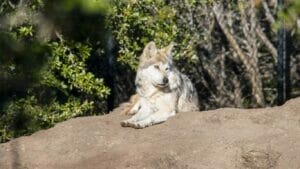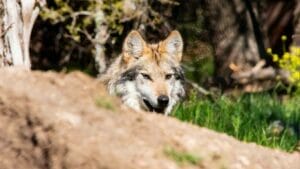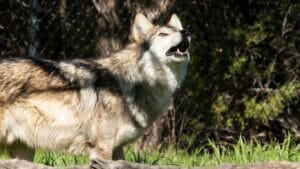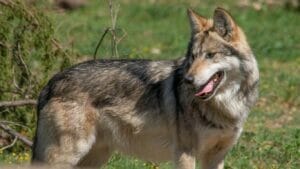
Appearance
The Mexican gray wolf, also known by its Spanish name, lobos, is the smallest of the gray wolf subspecies. Although these wolves boast the most genetically distinct lineage of gray wolves in the Western Hemisphere, they are the most endangered animals in North America. Adults have a mixed coat of white, gray, brown, tan, and a bushy tail which is mostly black. Their heads and paws are large, but their legs are long and lean to allow them to run when necessary.
Adaptations
Generally, the Mexican gray wolves’ diet consists of javelinas, rabbits, and other small mammals. They will work together in order to take down the larger prey, such as elk and deer.
Like all wolves, the lobo is a social creature with an intricate system of communication. However, because the primary prey of Mexican wolves is smaller than northern wolves, their pack sizes are probably smaller as well. For instance, a typical pack might consist of an adult pair and their offspring, in a territory encompassing up to several hundred square miles.
Conservation
The Mexican gray wolf used to be prominent in southern New Mexico, southeastern Arizona, southwestern Texas and central and northern Mexico back in the mid-1800s, but it was effectively eliminated from the United States by the mid-1900s. Wolves were trapped, shot, and poisoned by both private individuals and government agents, with rewards even being paid for each kill. Although this practice eventually ceased, populations did not effectively recover.
In 1976, the Mexican gray wolf was listed as endangered, so the U.S. and Mexico teamed up to try and save the species. The captive Mexican gray wolf program, also called the Mexican Wolf Species Survival Plan (SSP), began in 1977. By the start of the program, they were considered extinct in the wild.
In addition to this program, in 1982 the United States Fish and Wildlife Service approved the Mexican Gray Wolf Recovery Plan, which helped researchers develop new strategies to help wolf populations recover. At last, 11 captive-bred Mexican gray wolves were able to be released into the wild in a small area of Arizona and New Mexico.
Upon the conclusion of a 2020 survey, there were at least 186 Mexican wolves in the wild in the U.S.— a 14 percent increase from 2019 and the fifth-consecutive year of growth. Roughly 30 wild wolves live in Mexico, while approximately 350 live in captive breeding facilities across the United States and Mexico.
Fossil Rim has had Mexican gray wolves since 1990, when we first began to participate in the captive breeding program. Eventually, we primarily became a holding facility for animals that are not recommended to breed or are older in age. Despite this, nine pups have been born at Fossil Rim.
Where are they?
The Mexican wolves live in the Intensive Management Area and can be visited on a Behind-The-Scenes Tour.
VIEWING TIPS
These wolves are elusive, but they're usually easier to spot than red wolves.
Quick Facts
Scientific Name | Canis lupus baileyi |
Species Survival Plan | No |
Habitat | Mountains and forests |
Food | White-tailed deer, mule deer, elk, mice, squirrels, rabbits and sometimes carrion |
Originally Native To | Mexico and southwest U.S. |
Characteristics | Smallest of the gray wolf species with a coat containing black, brown, rust and gray |
Lifespan | Wild 7 - 10 years |
Social Behavior | Packs (alpha pair, their offspring and other non-breeding adults); lifelong mates |







